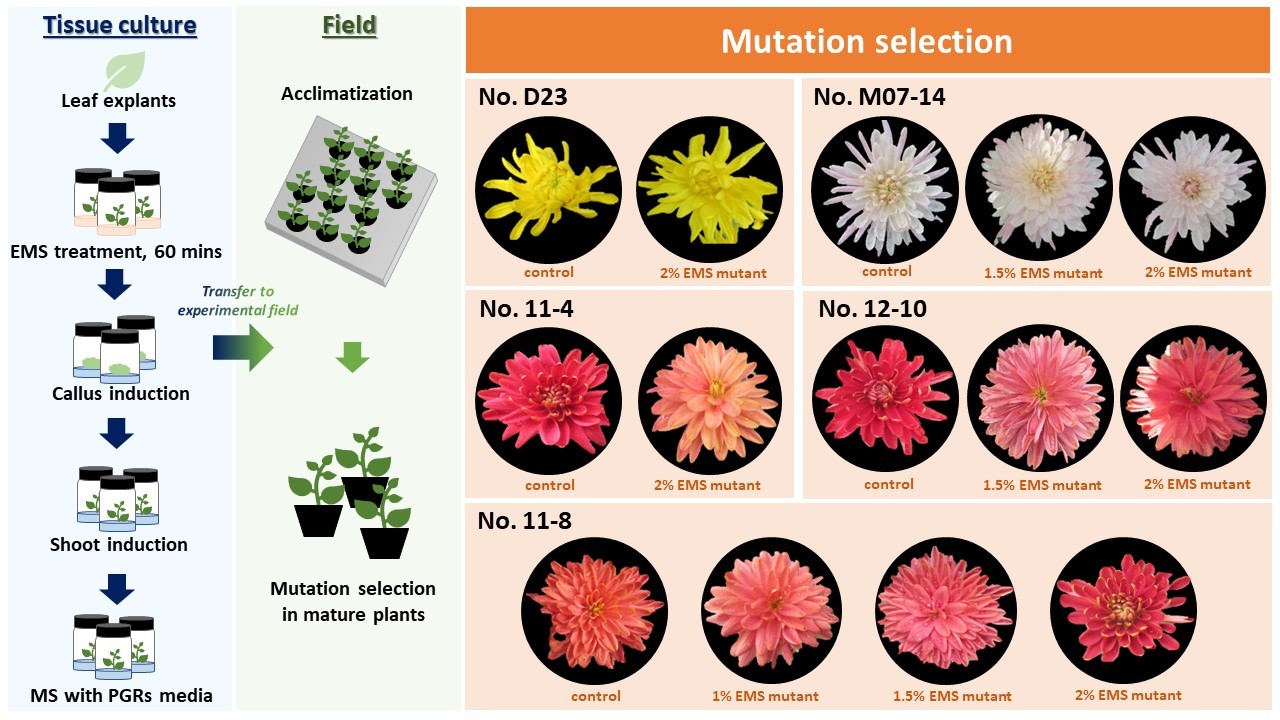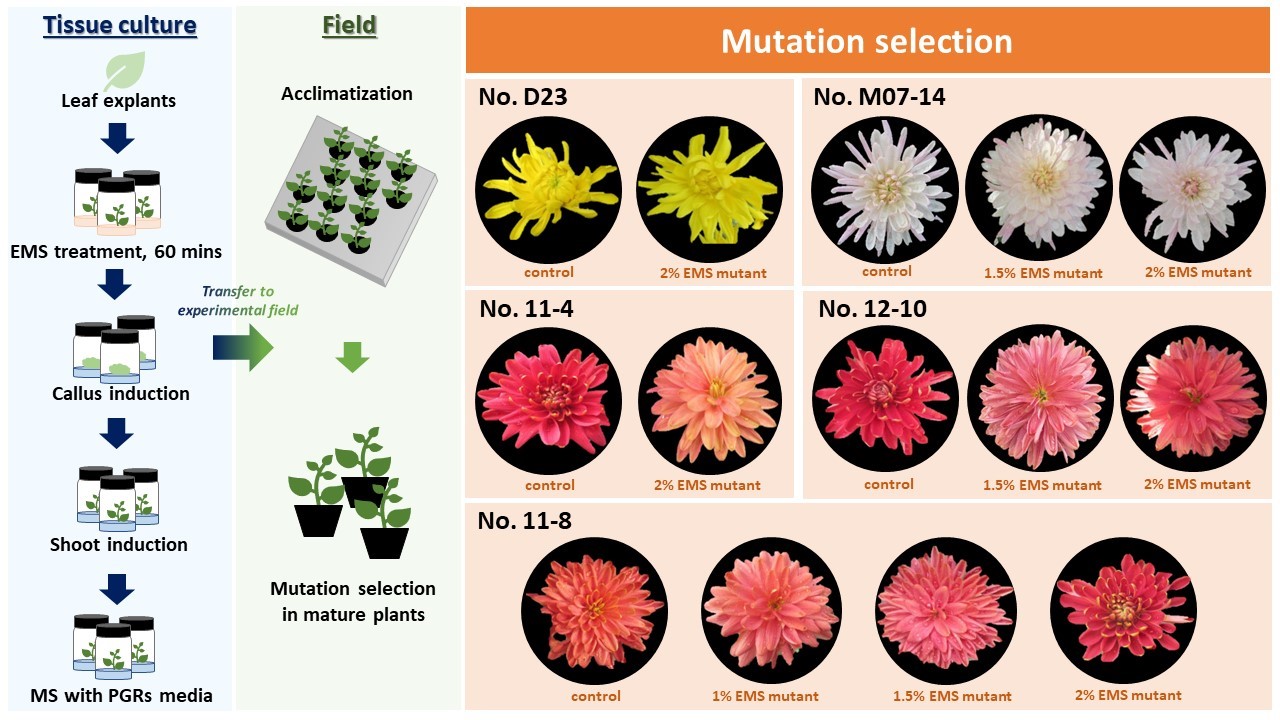Effects of Ethyl Methanesulfonate on Mutation Induction in Chrysanthemum spp.
DOI:
https://doi.org/10.48048/tis.2024.6904Keywords:
Chrysanthemum, Ethyl methanesulfonate, Tissue culture, Mutation breedingAbstract
Mutation induction using EMS agent has been widely and successfully used for variation enhancement. In this study, the cultured plantlets from leaves of 7 chrysanthemum varieties were treated with 0, 1, 1.5, and 2 % ethyl methanesulfonate (EMS) solution for investigation of its efficacy for mutation induction. All treated explants were cultured on MS media supplemented with 2 mg/L 2,4D and 1 mg/L kinetin for callus induction and shoot regeneration. After the plants were cultured for 4 weeks, the percentage of shoot and root initiation and callus formation were observed. The varieties of M07-4, D27, 11-4 and 12-10 showed shoot/root regeneration and callus formation while the M07-14, D23 and 11-8 varieties showed shoot/root regeneration in some bottles. The surviving explants were transferred into the new MS medium supplemented with 1 mg/L BA and 0.1 mg/L NAA to obtain healthy plants ready for planting. The healthy plantlets were transferred to soil pot plants, and grown at Doi Khun Wang, Chiang Mai province, Thailand, for acclimatization. Morphological differentiation was evaluated after 16 weeks of planting in greenhouse. M07-14 varieties showed a maximum of 5 mutant characters. 11-8 varieties showed 4 mutant types while D23, D27, and 12-10 varieties produced 2 mutant types and 11-4 varieties showed only 1 mutant type. EMS proved to be effective in producing mutated chrysanthemum flowering plants that can lead to changes the color and form of flower from the original.
HIGHLIGHTS
- Ethyl methanesulfonate (EMS) has been applied to induce mutation in chrysanthemum, which is ranked second in the global cut flower market, for enhancement in varieties and commercial value.
- EMS-induced mutation allowed various new characteristics of flower color and form dependent on EMS concentration and variety.
- All of chrysanthemum mutants which have the potential to be developed for commercial purpose were cultured in a tissue culture laboratory and prepared for commercial production in the next step.
GRAPHICAL ABSTRACT

Downloads
Metrics
References
C Broertjes. Improvement of vegetatively propagated plants by ionizing radiation. In: Proceedings of FAO/IAEA Sponsored Latin-American Study Group Meeting on Induced Mutations and Plant Improvement, Buenos Aires, Argentina. 1972, p. 293-9.
YS Luan, J Zhang, XR Gao and LJ An. Mutation induced by ethylmethanesulphonate (EMS), in vitro screening for salt tolerance and plant regeneration of sweet potato (Ipomoea batatas L.). Plant Cell Tissue Organ Cult. 2007; 88, 77-81.
SK Basu, SN Achaya and JE Thomas. Genetic improvement of fenugreek (Trigonella foenum-graecum L.) through EMS induced mutation breeding for higher seed yield under western Canada prairie conditions. Euphytica 2008; 160, 249-58.
V Puripunyavanich, A Piriyaphattarakit, N Chanchula and T Taychasinpita. Mutation induction of in vitro Chrysanthemum by gamma irradiation. Chiang Mai J. Sci. 2019; 46, 609-17.
International Atomic Energy Agency. Manual on mutation breeding. 3rd ed. International Atomic Energy Agency. Vienna, Austria, 2018.
C Auerbach and JM Robson. Chemical production of mutation. Nature 1946; 157, 302.
LS Lee, BJ Till, H Hill, OA Huyn and J Jankowicz-Cieslak. Mutation and mutation screening. In: R Henry, and A Furtado (Eds.). Cereal genomics: Methods in molecular biology. Humana Press, New Jersey, 2014, p. 77 -95.
J Jankowicz-Cieslak and BJ Till. Forward and reverse genetics in crop breeding. In: JM Al-Khayri, SM Jain and DV Johnson (Eds.). Advances in plant breeding strategies: Breeding, biotechnology, and molecular tools. Springer Cham, Switzerland, 2015, p. 215-40.
S Henikoff and L Comai. Single-nucleotide mutations for plant functional genomics. Annu. Rev. Plant Biol. 2003; 54, 375-401.
S Gnanamurthy and D Dhanavel. Effect of EMS on induced morphological mutants and chromosomal variation in Cowpea (Vigna unguiculata (L.) Walp). Int. Lett. Nat. Sci. 2014; 17, 33-43.
IM Henry, U Nagalakshmi, MC Lieberman, KJ Ngo, KV Krasilev, H Vasquez-Gross, A Akhunova, E Akhunov, J Dubcovsky, TH Tai and L Comai. Efficient genome-wide detection and cataloging of EMS-induced mutation using exome capture and next-generation sequencing. Plant Cell 2014; 26, 1382-97.
EA Greene, CA Codomo, NE Taylor, JG Henikoff, BJ Till, SH Reynolds, LC Enns, C Burtner, JE Johnson, AR Odden, L Comai and S Henikoff. Spectrum of chemically induced mutations from a large-scale reverse-genetic screen in Arabidopsis. Genetics 2003; 164, 731-40.
BJ Till, SH Reynolds, EA Greene, CA Codomo, LC Enns, JE Johnson, C Burtner, AR Odden, K Young, NE Taylor, JG Henikoff, L Comai and S Henikoff. Large-scale discovery of induced point mutations with high-throughput TILLING. Genome Res. 2003; 13, 524-30.
SK Senapati and GR Rout. In vitro mutagenesis of rose with ethylmethanesulphonate (EMS) and early selection using RAPD markers. Adv. Horticult. Sci. 2008; 22, 218-22.
J Fang and S Traore. In Vitro mutation induction of Saintpaulia using ethyl methanesulfonate. HortScience 2011; 46, 981-4.
M Ghani, S Kumar and M Thakur. Induction of novel variants through physical and chemical mutagenesis in Barbeton daisy (Gerbera jamesonii Hook.). J. Horticult. Sci. Biotechnol. 2013; 88, 585-90.
L Jiang and BL Dunn. Ethyl methanesulfonate and caffeine mutagenetic treatment to four ornamental Silene species. J. Environ. Horticult. 2016; 34, 95-100.
DY Lenawaty, D Sukma, M Syukur, DN Suprapta, W Nurcholis and SL Aisyah. Increasing the diversity of marigold (Tagetes sp.) by acute and chronic chemical induced mutation of EMS (Ethyl Methane Sulfonate). Biodiversitas 2022; 23, 1399-407.
S Rahmah. Induksi keragaman dua varietas krisan (Dendranthema grandiflora Tzvelev) dengan etil metana sulfonate (EMS) secara in vitro. Scientific Repository, IPB University, Bogor, Indonesia, 2011.
Z Hossain, AKA Mandal, SK Datta and AK Biswas. Development of NaCl tolerant strain in Chrysanthemum morifolium ‘Ram throung’ in vitro Mutagenesis. Plant Biol. 2006; 8, 450-61.
RR Latado, AH Adames and AT Neto. In vitro mutation of chrysanthemum (Dendranthema grandiflora Tzvelev) with Ethyl Methanesulphonate (EMS) in immature floral pedicels. Plant Cell Tissue Organ Cult. 2004; 77, 103-6.
V Yoosumran, S Ruamrungsri, W Duangkongsan and S Kanjana. Induced Mutation of Dendranthemum grandiflora through tissue culture by Ethyl Methanesulphonate (EMS). Int. J. Agr. Tech. 2018; 14, 73-82.
F Nasri, H Zakizadeh, Y Vafaee and AA Mozafari. In vitro mutagenesis of Chrysanthemum morifolium cultivars using ethylmethanesulphonate (EMS) and mutation assessment by ISSR and IRAP markers. Plant Cell Tissue Organ Cult. 2021; 149, 17.
S Chaidaroon and I Ungvichien. Research and development in producing disease-free chrysanthemums for promotion and technology transfer. Thailand Institute of Scientific and Technological Research, Pathum Thani, Thailand, 2016.
Data Bridge Market Research. Global flowers and ornamental plants market - industry trends and forecast to 2029, Available at: https://www.databridgemarketresearch.com/reports/global-flowers-and-ornamental-plants-market, accessed on May 2023.
International Rice Research Institute. STAR - Statistic tool for agricultural research. Star 2.0.1. Software. Biometrics and breeding informatics. Plant Breeding, Genetics and Biotechnology Division, Laguna, Philippines, 2013.
D Kapadiya, S Chawla, A Patel and T Ahlawat. Exploitation of variability through mutagenesis in Chrysanthemum (Chrysanthemum morifolium Ramat) var Maghi. Bioscan 2014; 9, 1799-804.
A Schum. Mutation breeding in ornamentals: An efficient breeding method? Acta Horticult. 2003; 612, 47-60.
H Liu, C Luo, D Chen, Y Wang, S Guo, X Chen, J Bai, M Li, X Huang, X Cheng and C Huang. Whole-transcriptome analysis of differentially expressed genes in the mutant and normal capitula of Chrysanthemum morifolium. BMC Genomic Data 2021; 22, 2.
M Mekapogu, BMK Vasamsetti, OK Kwon, MS Ahn, SH Lim and JA Jung. Anthocyanins in floral colors: Biosynthesis and regulation in chrysanthemum flowers. Int. J. Mol. Sci. 2020; 21, 6537.
R Pathirana. Plant mutation breeding in agriculture. CABI Rev. 2011, https://doi.org/10.1079/PAVSNNR20116032.
B McClintock. The significance of responses of the genome to challenge. Science 1984; 226, 792-801.
PJ Larkin and WR Scowcroft. Somaclonal variation - a novel source of variability from cell cultures for plant improvement. Theor. Appl. Genet. 1981; 60, 197-214.
X Wang, R Wu, X Lin, Y Bai, C Song, X Yu, C Xu, N Zhao, Y Dong and B Liu. Tissue culture-induced genetic and epigenetic alterations in rice pure-lines, F1 hybrids and polyploids. BMC Plant Biol. 2003; 13, 77.
G Duta-Cornescu, N Constantin, DM Pojoga, D Nicuta and A Simon-Gruita. Somaclonal variation - advantage or disadvantage in micropropagation of the medicinal plants. Int. J. Mole. Sci. 2023; 24, 838.

Downloads
Published
How to Cite
Issue
Section
License
Copyright (c) 2023 Walailak University

This work is licensed under a Creative Commons Attribution-NonCommercial-NoDerivatives 4.0 International License.






